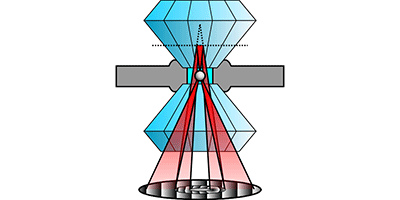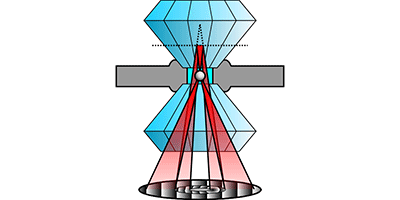Tweezers Work Well Under Pressure
Diamond anvil cells can apply millions of atmospheres of pressure to a solid or liquid, while allowing it to be observed through the diamond “windows.” For the first time, researchers have introduced optical tweezers into one of these cells in order to trap sample particles. The experiment, described in Physical Review Letters, directly measured the viscosity of the water surrounding the particles. Further development of this technique could permit investigations of the mechanical changes in biological cells and other soft materials placed under high pressure.
A diamond anvil cell (DAC) is a sealed volume sandwiched between the flat, millimeter-wide tips of two diamonds. When squeezed, the pressure in the cell can reach levels found in the core of the Earth. Diamonds are not only strong enough to handle these pressures, but they are also transparent to optical and x-ray probes. However, studying certain mechanical properties requires the controlled application of localized forces, which has been difficult to realize in a DAC.
For their force “handle,” Richard Bowman of the University of Glasgow, in the UK, and his colleagues chose optical tweezers, which are highly focused lasers that trap particles. To overcome the spatial constraints of a DAC, the team used part of their laser to create a second beam that reflected back on the cell. The combined beams trapped micron-sized silica beads suspended in a water sample. Because the optical forces were known, the random vibrations of trapped beads provided a direct measure of the water viscosity. The team recorded a threefold increase in viscosity for a pressure rise of atmospheres—a result that agrees well with previous measurements and builds confidence in the new technique. – Michael Schirber





